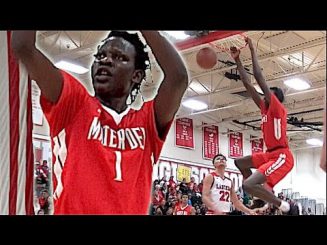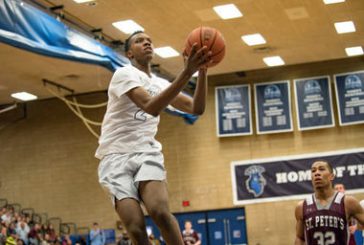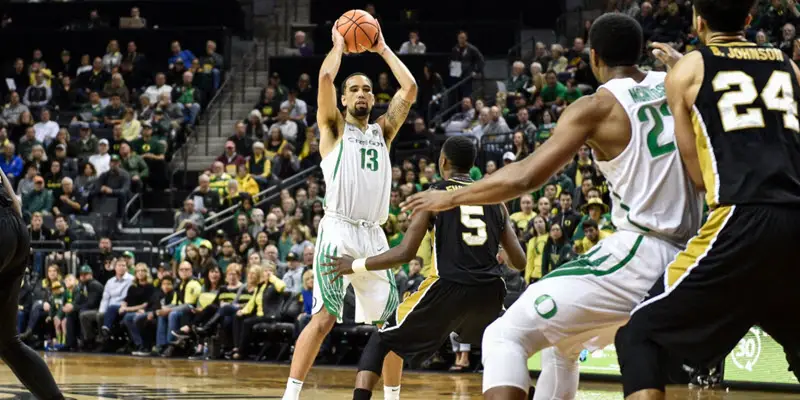Oregon’s rebuilt roster has some fans so excited you’d think the Ducks were favored to win the NBA title. Let’s just see if they can win the Pac-12 first, okay? Five returning players – Paul White, Payton Pritchard, Kenny Wooten, Abu Kigab, and VJ Bailey – will mesh together with that vaunted third-ranked recruiting class.
So, why is White a key to this team? He is the only proven returning scorer off the ball. Pritchard will score it, but the more he can facilitate for others, the better. The defense is loaded with length, shot blockers and willing defenders — but the Ducks lack proven shooters. White, Bailey and Louis King will handle the ball in the offense and have the size to shoot over smaller defenders off mismatches created by the weave offense. It’s those three who are the keys to Oregon’s offense.
Coach Dana Altman noted White’s ability to defend three spots (the shooting guard, small wing or big wing), and how that allows Oregon to match up in ways most teams can’t. This flexibility gives Oregon some ability to deal with the inevitable injuries as the season wears on.
The Newcomers

Bol Bol. Rim protector, 3-point shooter. Bol is a basketball unicorn.
Bol Bol is Oregon’s highest rated recruit ever, but he may not have the biggest impact as a freshman this season. Bol’s lack of muscle on the block allows defenders to push him around down low, and his face-up jumpshot will probably be inconsistent as he makes the transition to college basketball. Bol will defend the rim, alter shots, rebound and look a lot like Chris Boucher at times by stretching the floor and shooting the three.
Oregon’s rarely, if ever, had a player like King. His all-around game should have a huge impact. He’s long, athletic, scores in the open court at will and can jump out of the gym. King’s quickness could wreak havoc in Oregon’s zone-press defense. Look for him at the top of the press forcing passes horizontally instead of upcourt. When that happens time churns off the shot clock and Oregon can trap on the sidelines. Remember when Dwayne Benjamin was used this way? King may be even better in this role.
Will Richardson is another 4-star freshman who will play a key role. His 6’4″ size allows him sag defensively and recover with his length. Offensively, his ball-handling skills, willingness to create for others, and quick first step make him most likely to back up Pritchard at the point.
What To Watch
Why does Oregon’s length help them in the match-up zone? Length allows you to back up against the guy you’re guarding, then immediately recover by using your reach to get a hand in the shooter’s face. Oregon has seven players with the physical skills to do this effectively on the perimeter.
Who are the third and fourth leading scorers after White and Pritchard? I’ll predict Oregon’s third will be King who is a defensive matchup nightmare, and its fourth leading scorer will be Bailey, whose improved jumper now means he’s a consistent threat from behind the arc.
Is Wooten good enough to leave for the NBA after this year? His block totals may drop if Oregon’s perimeter D prevents penetration as well as it could. But Wooten has the talent to be another Jordan Bell and if back to the basket scoring ability improves, he’s a sure fire NBA player.

Louis King’s game could transform Oregon into an up tempo team this year.
King, Richardson, Pritchard, Bailey, Wooten and Kigab want to get out and run together. Everyone in that group is a terrific finisher at the rim. Fast break basketball isn’t about the guards, it’s about the wing players having the speed to get up court with the athleticism to finish the break. Until January, look for Altman to play the best defensive group that can also get out in transition and score easy baskets on the break. Getting points that way is important for this group because they don’t have a proven inside threat at the offensive end. (Francis Okoro could fill that role — more on that below.)
Water Cooler Notes
Oregon is the highest-ranked team in the Pac-12 to start the conference at No. 16 nationally, and most prognosticators have the Ducks exiting after the Sweet 16. (That feels about right.) If the freshmen develop faster than most, the Ducks could overachieve and reach even higher. They have the talent to make the Final Four, but they have to stay healthy, find an inside scorer by the time the tournaments start, and get 10 players integrated into Altman’s schemes quickly so they can rack up the wins and get a third seed in the NCAA Tournament.
Bol stated that one reason he liked Oregon was the way the Ducks handle social media. He believes Oregon’s a more modern school than some and he can relate to the way they tell their story to media and the fans.

Payton Prichard
Who starts? Wooten, Pritchard and White are locks to start so it’s really down to Bol, King and Bailey for the last two spots. I like Bailey’s chances a lot. He’s bulked up, shot a ton of jumpers this summer, and looks like a legit starting shooting guard. He also brings quickness and length to the perimeter D, and a burning desire to play defense — and we all know how much Altman loves that.
Pritchard, White, Bailey, Wooten and King might be Oregon’s best defensive lineup — so don’t be surprised if Altman starts that group at times and brings Bol off the bench. Oregon has eight quality players to rotate when you add those six to Kigab and freshman Richardson.
Two more freshmen would play immediately on almost every other Pac 12 team. Okoro and Miles Norris’ minutes will be determined by how many injuries the players ahead of them suffer, and how many points they can score on the block when they’re in the game. Okoro is the most likely to play early because of his ability to score on the block. No other Oregon big man has that skill set right now.
White will be the key early, and the development of King and Bol should be the keys to Oregon making a deep run in the postseason tournaments.
Bob Rickert
Lake Oswego, Oregon
Top Photo by Eugene Johnson
Related Articles:
Oregon Enters Playoffs Better Off Than Last Year
Will The Coaching Carousel Kill Oregon's CFP Chances?
The Playoff Formula Hasn't Changed
Oregon Aims to Bury Dawgs, Punch Playoff Ticket in Rivalry Clash
Huskies Are the New Beavers, Stay In Your Lane Kiffin, and the Civil Apple Cup War
Oregon Football: The X-Factor Vs. Washington
A native Oregonian, Bob’s spent 16 years covering Duck football and basketball for AOL Fanhouse, OregonLive and Rivals.com. He’s also hosted a sports talk show on ESPN Radio and led marketing for the Oregon Sports Hall of Fame.

